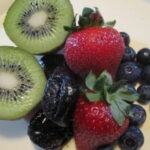Prunes, or dried plums, are one of nature’s amazing nutritional gifts. Few foods provide such rich and varied nutritional advantages as those that come packaged in the humble prune. Commonly known as the “constipation fruit” by many, this fruit has received bad publicity, making it a commonly avoided food. However, prunes actually have a good, unique taste and, if you know the right recipes, make a tasty addition to a healthy and varied diet.
Benefits of Prunes
As mentioned, prunes are a great tool for relieving constipation; this is due to their high fiber content and sorbitol, a stool loosening sugar found in prunes. However, the benefits of prunes extend far beyond this simple use. Prunes can help slow the aging process in the body, specifically in the brain. They are helpful in anemia and in the maintenance of normal blood circulation. They can also be used to treat simple sore throats. Finally, prunes are wonderful storehouses of antioxidants and beta carotene, both of which are highly recommended for the prevention of many cancers. Prunes are actually the richest food source of antioxidants, pound for pound.
Content of Prunes
Every 100 grams of prunes offers a storehouse of nutrients. Specifically, prunes provide a whopping 810 mg of potassium and 7 mg of iron, both essential components for healthy blood. 1890 I.U. of Vitamin A and 3 mg of Vitamin C will help to maintain healthy skin, hair and nails. Measuring in with a noteworthy 78 g of carbohydrates, prunes are sure to give you a long-lasting and healthy energy boost. All this and more, packaged into a reasonable 268 calories, makes prunes a low-calorie and low-fat addition to a healthy diet.
Other Possible Benefits of Prunes
Prunes continue to be studied for their many benefits and such studies consistently turn up new and interesting advantages to the consumption of this fruit. Recent studies have shown that prunes may be helpful in the prevention of osteoporosis, a common problem in those over 50 and especially among women. Other studies are attempting to pinpoint specific benefits for heart health and prevention of many types of cardiovascular disease. As a source of both chlorogenic acid and neochlorogenic acid, 2 uncommon phenol antioxidants, prunes likely provide benefits not associated with many other fruits.
Including Prunes in Your Diet
Though prunes can of course be eaten straight, and many enjoy them in this manner, prunes also make a tasty addition to many healthy recipes. Try one of the following to start benefiting from the tasty prune.
Prune Sauce
Ingredients:
1 c. orange juice
1 T. lemon juice
1 packet Sweet N’ Low or NutraSweet (or an equivalent amount of sugar)
1/2 t. ground cinnamon
1/4 t. ground ginger
24 prunes
1/4 c. chopped walnuts
Directions:
Mix together orange juice, lemon juice, Sweet N’ Low, cinnamon and ginger in a pot. Heat until the mixture just begins boiling. Add prunes and reduce heat to a simmer. Simmer for about 10 minutes, stirring occasionally, until prunes are plump and soft. Add the walnuts and cook for another minute or two, stirring occasionally. Remove the prunes and walnuts. Turn the heat up, cooking the sauce until it has been reduced in volume by approximately half. Pour the remaining sauce mixture over the prunes and walnuts.
Serve hot, or allow it to cool in the fridge. This is a great sauce to put over ice cream or frozen yogurt as a dessert. It can also be used as a topping for hot cereal, or even eaten by itself for a tasty treat.
Servings: 6 (4 prunes and appropriate amount of sauce per serving)
Ham Wrapped Cheesy Prunes
Ingredients:
20 dried prunes
½ c. fat-free shredded mozzarella
20 dry-roasted peanuts
4 slices of turkey ham
1 T. olive oil
Directions:
Stuff each prune with cheese and one peanut. Divide each slice of ham into 5 strips. Using a toothpick to hold it together, wrap each stuffed prune in a ham slice. Cook the wrapped prunes in a bit of oil until the ham is golden-brown and the cheese has melted.
An alternative is to use bacon instead of ham in this recipe. Each wrapped prune is a serving, making a significant number of servings quite easily. This is a great addition to a picnic or potluck; if you can convince everyone to try one, they’ll be pleasantly surprised!
Servings: 20 (each prune is a serving)
Prunes can also be easily included in dishes which call for added fruit. Examples of these would be muffins, meat recipes with apple included as an ingredient, trail mixes and fruit smoothies. Get creative and try some different ways to add this tasty and highly beneficial fruit to your diet.




